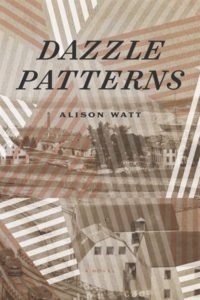 Alison Watt’s new book Dazzle Patterns takes the reader on a journey back to the year 1917. The setting in which the narrative takes place does not promise a positive experience: the town is Halifax, and the world is experiencing the terrors of World War I. The population of Halifax feels the consequences of the destruction when it suffers through the very real and now-famous Halifax Explosion, which killed and wounded thousands.
Alison Watt’s new book Dazzle Patterns takes the reader on a journey back to the year 1917. The setting in which the narrative takes place does not promise a positive experience: the town is Halifax, and the world is experiencing the terrors of World War I. The population of Halifax feels the consequences of the destruction when it suffers through the very real and now-famous Halifax Explosion, which killed and wounded thousands.
The story in Dazzle Patterns follows the life of Clare Holmes, who is preparing to work for the Red Cross while she waits for her fiancé, Leo, who is fighting in France. Clare sees all her dreams collapse after being struck by the explosion; she might very well represent people who struggle to survive in places and times where war kills all certainties and plans for the future.
The narrative is dark, but it gradually brings elements of hope and evolution that only appear in extreme times. Clare begins to take an interest in the art industry and takes classes at an art school; the beauty of painting acts as a counterpoint to the painful and cold reality of war. Here, the reader notices some changes happening in the characters, and the book shows people helping themselves, being supportive, and raising a family in a destroyed city.
For a moment, Watt makes the reader forget that the world was still at war and that Halifax was partially in ruins; this is where it’s possible to see the goodness that exists in the hearts of humans.
Perhaps the characters’ new dreams would not have come out were it not for the war.
But then new situations are brought to light and the dark colours come back, making the reader remember that the scene is not a romantic or a joyful one; uncertainty and mistrust still exist.
Dazzle Patterns is not easy reading. Many times throughout it, the reader can almost feel as if they were actually in Halifax, and they’ll want to get out of there.
The book shows the suffering of a world at war and proposes reflection on the consequences of acts of violence.
